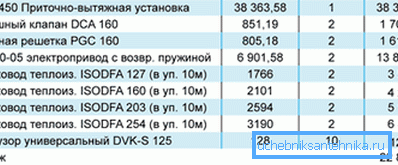Estimated ventilation: regulatory references and samples
What works may include estimates for the installation of ventilation? What norms of consumption of auxiliary materials and man-hour costs should be based on? Are there any standards for these costs? In our article we will try to answer these questions.

List of works
To begin with, we will decide what works can be included in the estimate.
Main
- Development of the project and preparation of project documentation.
Note: the project must be justified by calculations confirming its performance and the lack of redundancy in the performance of the designed system. It is obvious that the customer is interested not only in efficiency, but also in saving their own funds.
- If necessary - dismantling of the old ventilation system, partial dismantling of partitions, punching shafts in the ceilings.
- Installation of air ducts, air intake and supply umbrellas and grilles.
- Installation of fans, filters, heaters, air conditioning systems etc.
- A separate item is the estimate for the commissioning of ventilation.

Auxiliary
In addition to the actual installation and dismantling, the performer will:
- Transportation of materials and equipment.
- Loading and unloading (including the use of technology, whose work is paid separately).
- The construction of temporary sites, forests, etc.
- In the absence at the time of the commencement of work a stable power supply - supply of the construction site with its own generation of electricity.
Regulations
Two documents are useful when drawing up an estimate:
- State elemental estimate norms (GESN), section 20. They allow to estimate the need for resources (the same man-hours, the duration of the equipment, the number of rivets, etc.).

- Federal unit pricing (PER), section 20. This contains the estimated cost of each work performed during installation or dismantling. Rates are advisory in nature.
Note: in addition to PFR, there are also Territorial Unit Prices (TER), which are tailored to the specific local conditions (logistics, road conditions, seasonal temperatures, etc.). As a justification for budgeting can be used as FER, and TER.

We give short excerpts from both documents.
Hesn
According to this document, the following resources will be required for laying an air duct with a total wall area of 100 m2 with a wall thickness of 0.5 mm and a diameter of up to 200 mm:
| Type of | amount |
| Work time | 167.86 man-hours |
| Labor costs machinists | 1.3 man-hours |
| Hand winch operation time with pulling force up to 2 tons | 0.39 machine hours |
| Arc welder operation time | 1.79 car hours |
| The operating time of a truck with a lifting capacity of up to 5 tons | 0.78 machine hours |
| The duration of the crane with a capacity of up to 10 tons | 0.52 machine hours |
| Metal consumption for duct walls | 100 m2 |
| Consumption of construction bolts, washers and nuts | 0.015 t |
| Consumption of welding electrodes | 0,00045 t |
| Sealing mastic consumption | 0,00501 t |
| Asbestos Cord Consumption | 0,00089 t |
| Rubber gasket consumption | 8 kg |
Fer
But the estimated costs, on the basis of which the local estimate for ventilation is compiled, are from Federal unit prices for 2001. The same air duct with a wall thickness of 0.5 mm, with an area of 100 m2 and a diameter of up to 200 mm will serve as a model.
| Cost category | Value and units |
| Total direct costs | 2050, 56 rubles |
| Remuneration of workers | 1467 rubles |
| Machine operation | 134.14 rubles |
| Remuneration of machinists | 7.02 rubles |
| Expenses for unaccounted materials | 449.2 rubles |
To clarify: the materials incorporated in the project are a separate item of expenditure. Unaccounted materials are, for example, the replacement of a welder’s mask with accidentally crushed glass or broken flange of an adjustable wrench during a coupler. Since most of the installation work is done by hand, with the help of hand tools, the human factor will be the main item of unrecorded costs.

Sample
We hope that the instructions for budgeting in general terms is understandable to the reader. Now examine the sample. An example is the estimate of the ventilation device compiled by the Moscow-based Smeta-Moscow company; due to the limited scope of our material, we present only a short excerpt from its text.
| Position number | Justification (code and number of the regulatory document) | Item of expenditure | amount | Total cost of payment, rubles | The cost of operating machines, rubles | The cost of labor workers, man-hours |
| one | TER 20-06-002-01 | Installation of typical supply chambers with a capacity of up to 10,000 m3 / hour without irrigation system | one | 1045.98 | 155.29 | 50.27 |
| 2 | TER 20-03-001-02 | Installation of a radial fan weighing up to 0.12 tons | one | 180.28 | 21 | 10.35 |
| 3 | TER 20-02-019-01 | Installation of brackets for ventilation equipment (100 kg of product) | 0.08 | 1316.68 | 16.05 | 0.55 |
| four | TER 20-02-003-10 | Installation of steel louvered regulating ventilation grilles 150x150 mm | 15 | 36.1 | 8.38 | 18.45 |
| five | TER 20-01-001-02 | Laying aluminum or galvanized air ducts with a thickness of 0.5 mm and a perimeter of up to 600 mm (100 m2 of surface) | 0.025 | 3123.92 | 216 | 4.83 |
| 6 | TER 20-01-001-03 | Laying aluminum or galvanized air ducts with a thickness of 0.5 mm and a perimeter of 800, 1000 mm (100 m2 surface) | 0.36 | 2890.74 | 172.91 | 63.63 |
| 7 | SCM-300-9066-1 | Galvanized steel air ducts with a thickness of 0.5 mm (m2) | 38.5 | 9799 |

Conclusion
We hope that our material will help the reader to orient in the preparation of estimates. As usual, you can find additional information in the attached video in this article. Successes!